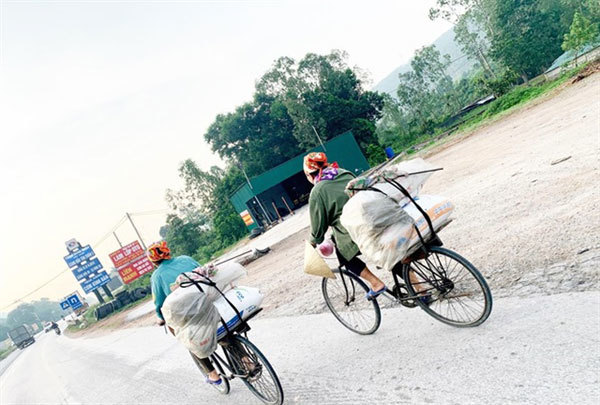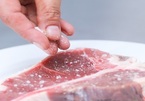 |
| Women from Dien Van Commune ride bicycles to sell salt. — Photo tienphong.vn |
On the 51ha salt field of Van Nam Co-operative in Dien Van Commune, Nghe An’s Dien Chau District, dozens of people are working under the summer heat.
“It’s sunny, it’s good for us,” 85-year-old Dang Van Phat said happily at about midday, as with the outdoor temperature 40 degree Celsius, brine was evaporating.
Phat’s bare feet were in a brine pond, his hands holding a rake he used to break the dried soil layer in the pond. Sweat appeared on his forehead, crawled its way down his cheeks and chin and then disappeared before landing on the soil.
“Three generations of my family make salt. This is hard work,” he said.
“When people seek shade to avoid the sun’s heat, we keep working even without taking a rest at noon,” he said, adding that the work only made them enough money to make ends meet.
Phat said salt makers started working in the early morning and finished late at night.
Cracked hands and feet, sunburned hairs and skin, for more than 70 years working as a salt maker, Phat has never checked the temperature at the salt field at noon.
He said the sunnier it was, the better the salt would be.
A salt season usually lasts from May to August and peak production time falls in June and July which are usually accompanied by heatwaves reaching the central region.
Dang Thi Thao, 55 years old, of Dien Van Commune’s Van Nam Hamlet, said her family could not sell salt during the COVID-19 pandemic and social distancing, so heaps of salt was still at the storehouse.
“It’s not simple to make transparent salt crystals,” Thao with her experience of 40 years said, explaining that flat ground in the pond and high concentration of salt in seawater were key to quick evaporation and forming salt crystals.
After one-day of evaporation, white salt will regularly appear in the pond but this means salt makers have to work in harsh conditions.
“Hardship is added when it rains,” Thao said, recalling wet nights when she and other salt makers pushed each other to go to the salt field and cover salt ponds carefully or they would lose the unharvested salt.
“Some people stayed at the salt field the whole night and the following morning, they got up with white hairs because of salt,” Thao said.
There are about 400 families making salt in Van Dien Commune, Dien Chau District and women in the families are normally in charge of selling the product.
Tran Thi Hanh, 57 years old, said that she had been selling salt for more than 40 years.
“In the past, we carried salt on a shoulder yoke and walked everywhere to sell it,” she said, adding that now, they rode bicycles or drove motorbikes instead.
Hanh said she and other women in the neighbourhood usually rode the bicycle for about an hour from their village to An Market in Ma Thanh Commune, Yen Thanh District.
They would be there until midday, then, if anyone hasn't sold all of their stock, they would ride along roads like vendors.
The vendors speak loudly when riding at the same time: “Anyone wants to buy salt? The salt's here!”
“On lucky days, I sell all my salt and go back home early at about 2 pm. On unlucky days, I have to cut the price or sell the salt on credit,” Hanh said.
“As summer rains usually come suddenly, we salt vendors would rather be wet than leave the salt wet in case we cannot find any shelter,” Hanh said.
She said that she was able to carry about 100 kg of salt daily; each kilo could be sold at VND3,000-5,000. She earns about VND40,000-60,000 (US$ 1.72-2.58) per day.
In the past few years, salt makers in Dien Van Commune started using trucks to bring their salt to mountainous areas of Nghe An where they could sell a kilo of salt for VND7,000.
Normally, each trip lasts a few months and they could earn about VND4 million ($171).
Seller Nguyen Van Lam said he hired a truck to carry 5 tonnes of salt to Ky Son District. After arriving in Muong Xen Town, the salt would be carried by motorbike to remote hamlets like Muong Long, Muong Tip and Nam Can.
On the way to some remote hamlets, motorbike roads were not built and people had to carry the salt by themselves, Lam said.
According to Nghe An’s Rural Development Division, more than 5,000 households in the province make salt in a total area of nearly 700 ha. Last year, about 58,500 tonnes of salt was made in the province, mostly in Dien Chau and Quynh Luu districts.
Le The Hieu, head of Agriculture and Rural Development Desk of Dien Chau District told Tiền Phong (Vanguard) newspaper that the salt-making area in the district was more than 120 ha last year but now was about 100 ha, producing some 6,435 tonnes.
“Making salt with the traditional solar evaporation method can not compete with industrial salt production,” Hieu said, adding that the work generated low income, thus failed to attract young labourers.
Dien Chau District planned to invest more in salt production infrastructure, calling firms to buy, process and diversify products related to salt, Hieu said. VNS

Salt field shrub a Nghe An specialty
About 250km from Hanoi, Quynh Bang Commune in the central province of Nghe An is home to a tasty surprise ahead.

Vietnamese consume salt twice as much as WHO-recommended level
The amount of salt recommended by the WHO is below 1.5g for under one-year-old children and less than 0.3g of salt for infants.
 The heat of summer is here and while many people are longing for the cooler days of autumn, the salt makers in the central province of Nghe An are thrilled to see the sun.
The heat of summer is here and while many people are longing for the cooler days of autumn, the salt makers in the central province of Nghe An are thrilled to see the sun.